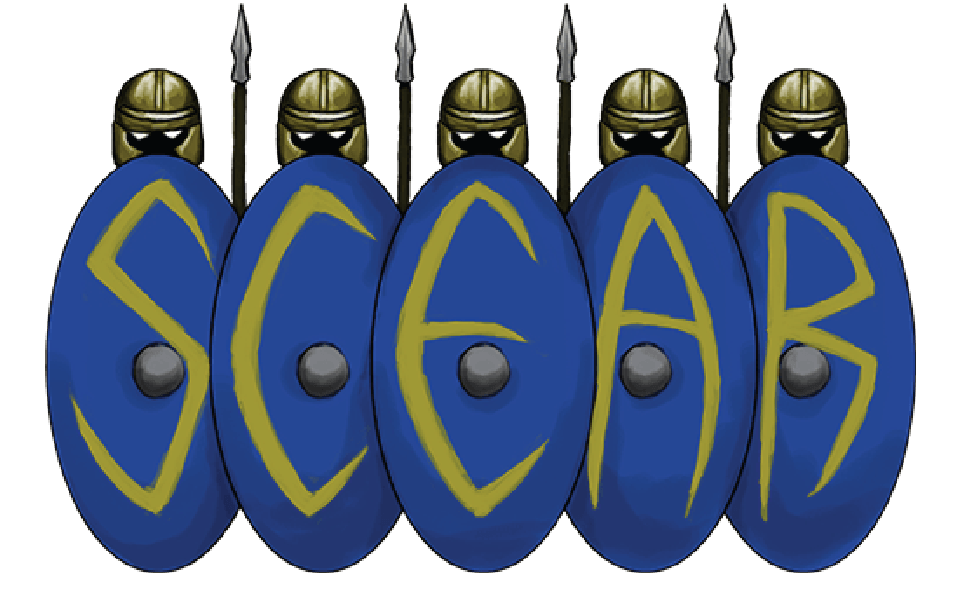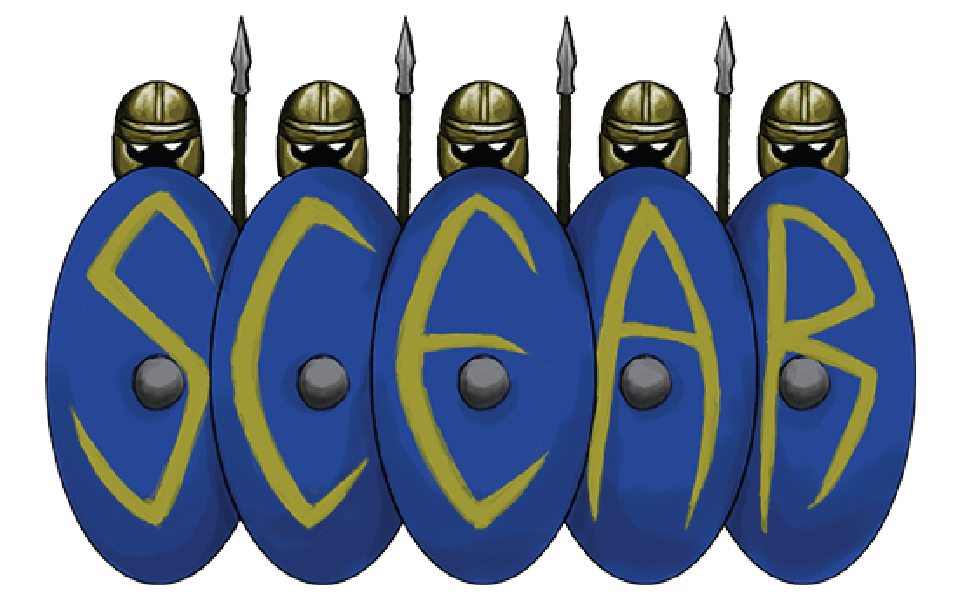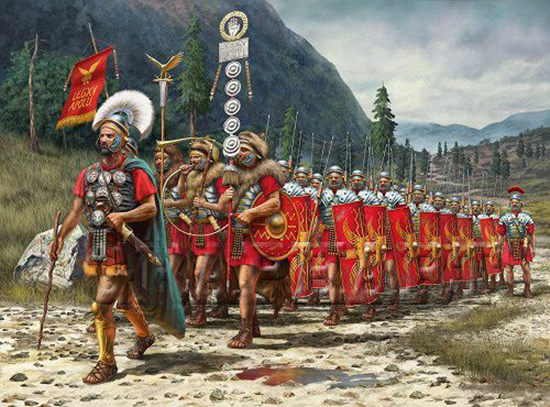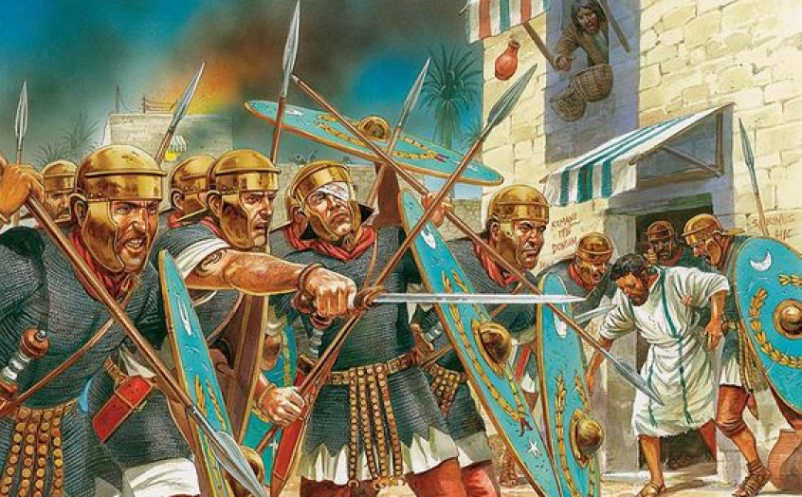Clipeus : Shield of roman auxiliary troops
Clipeus: Shield of roman auxiliary troops. Shield was a recognisable part of infantry units across the ancient history. Shield provided protection not only in hand to hand combat, but as the screen bodies of soldiers from the missiles casted from afar by slings, bows or javelins. Shield was specifically adapted to the battlefield role by its shape and materials used in production. Let's mention Greek heavy bronze hoplon, Persian wicker shield called spara deployed to the ground with a spike, or Thracian wooden pelta covered by leather. Hoplon was a basic equipment of heavily armoured phalangites. Sparas were used to shield light infantry and archers while deploying arrows from afar. Peltas were crescent shaped shields. Their shape both helped to screen body while aiming the javelin and to be the ritualistic symbol of goddess Artemis, patron to the huntsmen and bowmen. Designs of those shields changed in time according to their need on battlefield. In the beginning of the roman principate, battlefields were dominated by scutum, shield of roman legionaries. Auxiliary units of the roman army were equipped by clipeus shield type of the elipse shape.
Cipeus and its origin
Clipeus is the latin term originating most likely in greek verb καλύπτω, kalúpto - to cover. In the times of early Roman republic romans fought in fashion of greeks and used rounded shields, inspired mostly by hellenes from the southern Italian colonies. Rounded shields used term clipeus in latin from before 4th century B.C. Oval shape of clipeus was probably influenced by several sources later on.
In western Mediterranean it was Celtic and Celto-Iberian influence. Annexation of eastern Hispania (Hispania Citerior) in 2nd century B.C. and Sertorian revolt in 1st century B.C. brought in many military innovations to the growing Roman republic. For instance lets name adoption of gladius hispaniensis of the Iberian design. On the side of opponents of the republic, Romans took on Celtic and Celtiberian specialised foot regiments equipped with oval shields that preferred hit and run tactics and showered roman army with hail of javelins before strike.
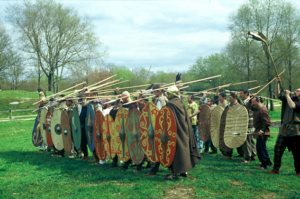
Celtic shield wall, reconstruction.
Eastern Mediterranean was shaken by the invasion of migrating Celts - Galatians - settling in Anatolia. They established kingdom - Galatia in the area of Ankyra (modern day Ankara, capital of Turkey). Galatians were integrated in the affairs of the eastern reaches of ancient world and apart from their own wars they served as mercenaries, e.g. in Egypt then ruled by Macedonians. Usage of oval shields came to greeks, as is displayed on stele of Diouskourides of Ptolemaic Egypt. Type of shield borrowed from Celts was called thýreos (thýra - doors). Thyreophoroi (thyreos bearers) were back in greek army equipped very similarly as the later roman army auxiliary troops.
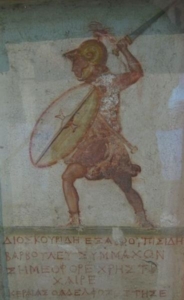
Thyreophoros of the Diouskourides stele from Egypt.
Clipeus in the roman army
In 1st century A.D. used by light infantry that served as javelin (verutum) throwers and in case of need ther served as spearmen on the wings of legionary manipula/cohors. Sometimes in 3rd century A.D. during military reforms, roman scutum is excluded from army definitively. Reasons were requirements on mobility and ability to face armies equal to that of the romans. Scutum that was most eficient to face tactically less developed enemy ceases to be the advantage in the engagement of equal opponents.
These formations were equipped by larger arsenal of missiles and throwing weapons e.g. plumbata donned on the inner face of the shield. Clipeus is lighter, more mobile and enables to create looser formations with gaps between soldiers according to need. Clipeus was also used by cavalry troops, for instance the infamous Batavian cavalry from northern Gaul (present day Belgium and Netherlands). Clipeus becomes primarily used shield in Roman military up to western empire's end, and its development continues in Eastern Roman Empire.
Manufacture of clipeus
Clipeus was made of plywood bound by parallel and cross ribs, covered by raw hide and linen cloth, or even just by layers of cloth. Boss in the center was called umbo and rim was encased by thin metal plates, occasionally by leather. Cohort was recognisable by the motif on the front face of the shield.
Romans knew the technology of the plywood and were able to create sturdy and flexible plates of shield corpus. Dimensions of clipeus were 125 cm by 90 cm. Primary cross and parallel ribs run through centres of the back wall and there were thinner secondary ribs that reinforced the rims (picture.)
The success of shields was in the cover made by raw hide. Hide of the 1mm of thickness is similar to thin metal plate in dry state, and its flexibility endured hard blows. We know of the cases from 19th century where raw hide shields endured even top notch rifles of the period. Romans used cow hide. It is stretched on the shield after it was soaked in water for about four hours and it is able to take desired shape. Founding of the roman shields in Dura Europos (Syria) are the testament of usage of leather stretched by raw hide on the rims of the shields.
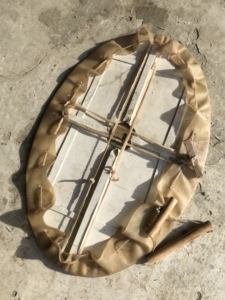
Stretching and binding of wet hide to the wooden corupus.
Phase of the stretching of wet leather is called shaping. It is important due to forming exact oval shape of the shield. It is done by punching holes into wet leather and lacing the hide with hide strips along the circumference of the shield board. Whilst drying, hide clenches to the rims. According to workplace temperature, we tend to moisten the rims of shield to prevent bending and breaking of the board due t o immense pressure dealt by the material.
This material shrinkage is going through several phases. According to the shield construction, the shrinking puts the strain on board mostly in vertical direction. It is necessary to calculate with this and use several methods to prevent deformations during this phase. One of these is putting weight onto the material, where the shield is bent against the direction of material pressure. We use 60-90kg of weight according to the need, durability and thickness of the materials used and work temperature.
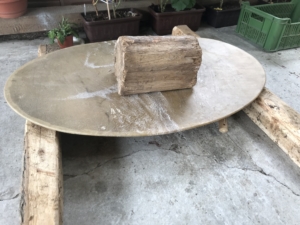
Using weight to prevent bending while material is drying.
Second option is the usage of the torsion screws that use the principle of the torsion force. Torsion force was very well used by the roman military engineers mostly in sieges e.g. in construction of ballistas used in sieges and field battles as well. To make these torsion screws, we need two or more thick hide stripes that are turned around each along the axis of the stripe with the wooden bar. This way we may create sufficient force to counterbalance the bending of the material. This are the ways to allow the hide to dry out securely and prevent destruction of the material.
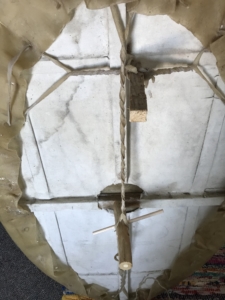
Usage of torsion screws while stretching the hide
Process of the making takes approximately seven days according to need and conditions. While using torsion screws to balance out changing forces during the drying process.
After this phase we need to fixate the results. First step is to dress hide into the layer of cloth that will isolate hide from soaking the air humidity. By encasing the rim by metal bars we fix any other possible deformations of the plywood underneath the layers of cloth and leather.
Manufacture of the shields in roman army was curated by skillfull masters of craft that selected best raw materials and were able to predict the material behaviour during the process of making. They were often put before Herculean task to provide dozens of pieces of equipment in one go. In our association we were experimenting several weeks to get the results we wanted.
Conclusion
Shields of the foot regiments had their undisputed place in the in the military history. Shield was priceless companion to the fighter and signified both his position in battle order and function in fray. Clipeus made its way to the primarily used shield in Roman army. Shield that gave its bearer protection from arms and projectiles was proven to fulfil the demands on mobility of formation. Its manufacture required knowledge of the materials whilst quality shields served battered in action for several years.
Tomáš Vardzik
